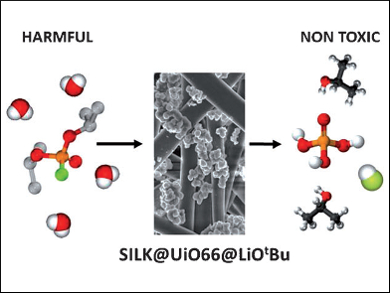Filters Adsorb and Degrade Chemical Warfare Agents
Air filters, such as those used in masks, for protection against chemical weapons are mainly based on the adsorption of toxins. Such filters have a limited capacity to capture the toxins and once they are contaminated can become a dangerous source of emissions themselves. Spanish scientists have now introduced a new approach for making self-detoxifying filters that can degrade the chemical weapons. As reported in the journal Angewandte Chemie, these filters are based on air-permeable textiles that are impregnated with special, catalytically active metal–organic framework materials.
The disadvantage of conventional activated carbon filters is that though they initially adsorb chemical weapons, they do not destroy them. Contaminated filters are thus dangerous and must be disposed of at a significant cost. A preferable alternative would be filters that not only capture highly toxic substances, but also immediately degrade them.
Metal–Organic Framework Materials as a Catalyst
A team headed by Jorge A. R. Navarro and Elisa Barea, Universidad de Granada, Spain, and Instituto Murciano de Investigación y Desarrollo Agrario y Alimentario, La Alberca, Spain, has now developed a new technique for making self-detoxifying filters. Their approach is based on metal–organic frameworks, which consist of metallic “nodes” bound into three-dimensional frameworks by organic components that link them together. The resulting materials are highly porous crystalline solids that can adsorb molecules into their pores. Given the right composition, these materials can also be catalytically active. The researchers made use of this trait to create an MOF tailored to make chemical weapons harmless.
Their starting point was a zirconium-containing MOF called UiO-66, whose special structure allows it to split organophosphates in the presence of moisture. The researchers additionally incorporated special organolithium compounds into the framework. This produces a significantly more catalytically active material that very efficiently splits the phosphorous–fluorine, phosphorous–oxygen, and carbon–chlorine bonds commonly found in chemical weapons.
Air-Permeable Textile Filters
The scientists impregnated silk fabric with this newly developed MOF, which forms nanocrystalline deposits on the silk fibers. This results in air-permeable textiles that can rapidly and efficiently detoxify chemical warfare agents, as demonstrated with tests using harmless, but chemically similar model substances.
The reported breakthrough might be of interest for the future development of self-detoxifying filter technology for both individual and collective protective systems.
Another strategy with the same starting point was chosen by American researchers: by varying the structure of the UiO-66 framework, they were able to achieve a very quick hydrolysis of nerve gas simulants in a plug-flow reactor.
- Textile/Metal-Organic-Framework Composites as Self-Detoxifying Filters for Chemical-Warfare Agents,
Elena López-Maya, Carmen Montoro, L. Marleny Rodríguez-Albelo, Salvador D. Aznar Cervantes, A. Abel Lozano-Pérez, José Luis Cenís, Elisa Barea, Jorge A. R. Navarro,
Angew. Chem. Int. Ed. 2015.
DOI: 10.1002/anie.201502094
Also of Interest
- Instantaneous Hydrolysis of Nerve-Agent Simulants with a Six-Connected Zirconium-Based Metal-Organic Framework,
Su-Young Moon, Yangyang Liu, Joseph T. Hupp, Omar K. Farha,
Angew. Chem. Int. Ed. 2015.
DOI: 10.1002/anie.201502155



